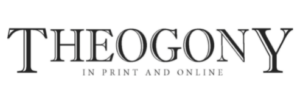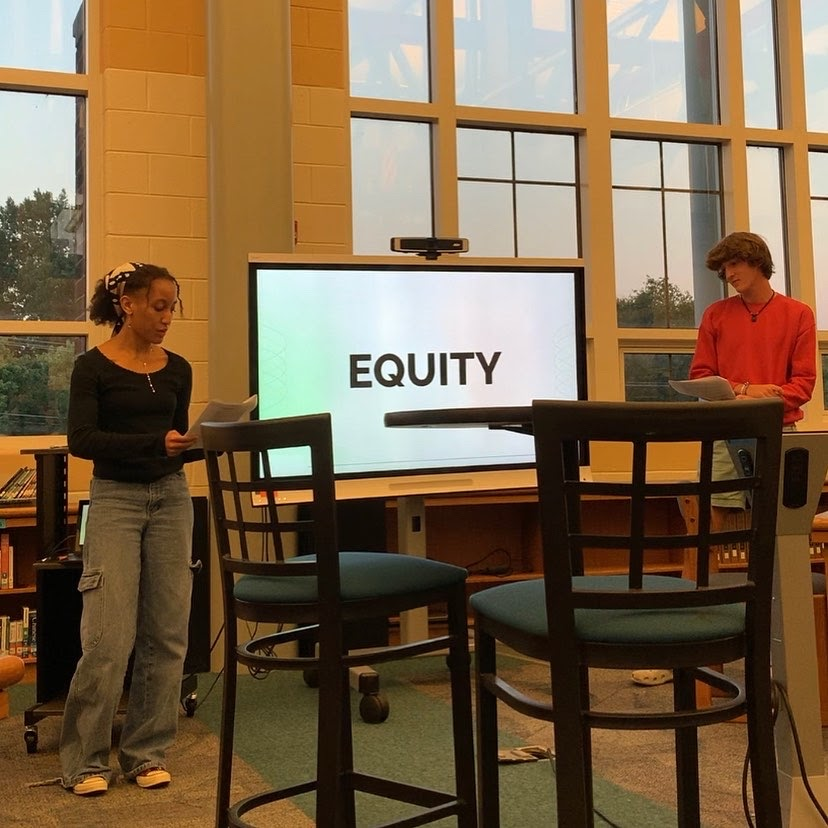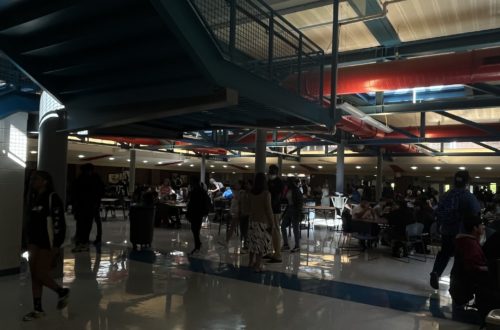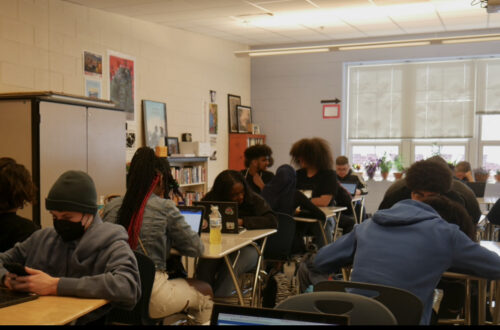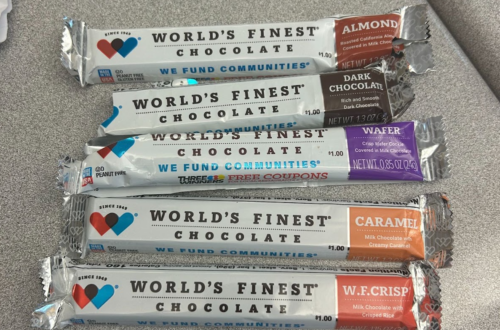Although the push for a 74-minute lunch program wasn’t successful, there’s a lot we can learn from it. I’ve been on the Student Lunch Committee since its foundation. Here’s what I saw.
Yahney-Marie Sangaré
Editor
Additional commentary, reporting and perspective were provided by James Libresco.
Disclaimer: This article is written from the opinionated perspective of Yahney-Marie Sangaré and James Libresco. Both are members of the Student Lunch Committee (SLC) and have invested personal time and energy into reinstating Titan Lunch. For unbiased reporting on Titan Lunch, please refer here. Theogony Editor Emily Milton and Staff Writer Salma El Gourchal are members of SLC but were not involved in the writing of this article. This article does not represent the views of every member of SLC.
On January 24, 2023, Student Lunch Committee members stand in front of the main entry doors of ACHS. One passes out brightly colored signs with bold text as the other directs students across a strip of road to the entry of the football field. In the passing time between second period and the 30-minute Titan PRIDE block, whispers echoed in the hallway: “Are you going to the walkout?” asks one student to another in a flash of backpacks. Blue-colored Canva posters are tacked to the columns in the cafeteria and a social media post advertising the “Titan Lunch Walkout” garners hundreds of likes on social media. Whether it be due to the presence of school administration, benevolent and cautious towards the display, or the painfully dubious nature of the Titan Lunch decision, there’s a sense of something impending.
Everyone on the committee is holding their breath as people begin to trickle out of the building’s front doors. Perhaps it’s the sense of scale that tilts the situation. Or maybe it’s the dramatic irony. There’s something the organizers, staff and teachers know that most of the attendees don’t; the strange, complex, controversial and somewhat obscure push for Titan Lunch did not start that Tuesday. If anything, it ended then.
The movement for Lunch and Learn, the antiquated name for the program ACHS adopted for its immediate post-pandemic year, began before some of the committee’s most active members were even enrolled in high school. The idea of a universal lunch program isn’t quite an original one; in 2020, students were rolled into focus groups asking for their opinions on a universal lunch block that would promote social, emotional and academic learning. The presentations were peppered with stock images of smiling adolescents, a sandwich in one hand and a pencil in the other, lit with fluorescent lights and grinning. In early 2021, when the first student committee launched an online form (created by myself) asking then-T.C. Williams students their thoughts on a potential Lunch and Learn system (given the example of Cherokee High School’s “Community Lunch and Learn” program established six years prior), 75.3% of students were in favor. The remaining 22.6% voted maybe, and 2.1% said no.
Although it was far from a representative population (as was virtually impossible in the pandemic era), students were clearly open to change. As teachers and staff, who had been aware of the idea for years, saw their project finally begin to blossom, students could not conceptualize the extent to which Lunch and Learn would change the experience of ACHS.
“Lunch and Learn was literally the only way I was able to participate in extracurricular activities. For 9th and 10th grade, I wasn’t able to do anything whatsoever, but that changed in 11th and 12th,” said alumnus Atiya Idris (‘22) for a testimonial form conducted in August 2022.
“L&L was the most wonderful thing that could have ever happened to me in high school. I was able to join clubs, and take leadership positions in them, for the first time,” said alumnus Sabine Mead (‘22) on the same form.
Lunch and Learn came at an infamously perilous time. The 2021-2022 school year was multifaceted. Sensationalized reporting advertised daily “brawls” at the nearby Bradlee Shopping Center that occurred in the aftermath of two years of isolation on the frontal cortexes of teenagers. Simultaneously, a ferocious debate on the role of student resource officers (SROs) took shape. The mental health effects of the pandemic, alongside the complex role of SROs in a post-Black Lives Matter revitalization, gave ACHS, alongside many other schools in the nation, a tumultuous year of re-opening. A non-refined program burdened with a nationwide staffing shortage resulted in issues with who was on and off campus, and a lack of sufficient verification technology with a school of over 4,000 students left staff wondering how to support the program. It was obvious that there were imperfections, and maybe Lunch and Learn exacerbated them, but it was hardly specific to those 74 minutes of the day and much less to ACHS.
Conversely, Lunch and Learn gave rise to some considerable brilliance and opportunity. The first Black Student Union meeting of the year drew in over 80 students, an incredible turnout. Lunch and Learn was the genesis of fresh clubs and affinity groups with a newly socially conscious generation. The Asian Pacific Islander Union, for example, first emerged during Lunch and Learn, and the Muslim Student Association and Latinos Unidos saw their meetings widely publicized and attended. Young Democrats brought in Mayor Justin Wilson to speak with students about local issues during their lunch hour. Black Student Union’s forum on SROs was attended by Alexandria City Councilmember Canek Aguirre, who commended students on their commitment to the cause. Student-athletes, workers and any of those whose free time generally stopped at 3:15 were now invited into a vibrant environment of academic intervention, social support and gathering. During February, for the first time, Black Student Union’s lecture series attendance incorporated an open block, allowing students to choose to further their knowledge of Black history rather than rely on their teachers to choose to sign up their classes. Before Advanced Placement exams, teachers held review sessions and offered to tutor during the lunch block. Counselors opened their doors for support that didn’t interfere with learning time. The Writing and Math Centers flourished. Student autonomy, when used responsibly, was empowering to an unspeakable degree.
In May 2022, violence at the nearby Bradlee Center involving a mixture of students from Minnie Howard and King. St Campus led to the death of a King St. student. The community stood still. ACHS was closed for the weeks that followed up until the end of the school year. The narrative created in the media incorporated the words Lunch and Learn, so it was the logical decision to conduct a rigorous investigation into the circumstances leading to the student’s death and how they could be prevented in the future to ensure this never happened again. Although the students involved were dismissed from SOL testing and the death did not occur on campus, there was a reasonable and needed investigation into how Lunch and Learn may have played a role. At first, no one was sure exactly what happened, and by the time the facts came out, explosive Twitter reactions and media coverage had already forced the hand of former Superintendent Dr. Gregory Hutchings and Central Office to bring Lunch and Learn to a halt.
A student’s life means more than any program. Indisputably. There is no marginal benefit that could be placed above anyone’s life. If not having Lunch and Learn would have prevented the student’s death, it would be the immediate wish of the SLC and all stakeholders to immediately dispose of it. But that wasn’t the case. Many factors went into the death of the student, and to simplify it to a 74-minute lunch block, as several have done online and in speech, is absurdly disrespectful. We refuse to use tragedy as a mechanism of propaganda or to spread any belief within its context without all knowledge considered. We let our knowledge of it inform us while acknowledging that most situations are much too complex to be summarized in one policy or another. And if Central Office were to have explained that this, above all, was what caused the death, there would have never been an SLC. But that is not the case.
By the time the next school year began, it seemed Central Office had come to the same understanding. In a meeting of SLC members and Central Office employees in October, one reluctantly admitted that they had “probably pulled the plug on the wrong program,” although they acknowledged Lunch and Learn needed revision. The majority of the students that were involved in the incident never stepped foot on campus on the day of the fight. There was a lot at play, but Lunch and Learn didn’t seem to be the deciding factor, and if it was, no one was telling us so. So why were we treating it that way?
On August 8, 2022, an email sent out to parents was distributed among students announcing that there would be no Lunch and Learn in the 2022-23 school year. Immediate uproar followed; first on social media, and then in the inbox of Principal Peter Balas. There was almost instantaneous panic; how were clubs going to run? How would students seek out teacher help? Most students had never attended ACHS in-person before Lunch and Learn was implemented. This was unforeseen; certainly, no one was aware of this change when selecting their rigorous courseloads that they expected to tenuously balance with a 38-minute study session. On Twitter:
Thanks for taking away L&L ACPS! Really appreciate how that ruins student involvement in clubs and extracurriculars who otherwise would not have access!
@yahneymarie
Reply: They took it away?!
@james_libresco
ACPS had just given birth to a year of discourse over a lunch schedule. Out of context, it’s almost ridiculous. But within the shakiness and uncertainty of a post-pandemic adolescent’s place at a school of 4,000 students, the backlash becomes more understandable.
The initial email screenshot, grainy and transmitted through Instagram stories, was relatively vague. It would take longer to understand the exact details. Originating from replies on a social media post, a group of students tasked themselves with the tedious job of reinstating a 74-minute universal lunch block. This group would eventually become the Student Lunch Committee. Students from the replies quickly created a group chat, titled “operation get L&L back,” which then morphed into hundreds of daily messages and a good half-dozen Facetime calls. On August 17, 2022, six students, myself and James among them, met with Balas.
Balas explained that this wasn’t a School Board decision, as many had assumed, but a Central Office one. An independent safety council hired by ACPS had recommended that Lunch and Learn be dissolved in the aftermath of the student’s death. Hutchings officially pulled the program just before his term ended.
After the meeting, I shared what Balas had revealed to the committee in a Twitter thread. Among the long series of tweets, there was the first glimmer of hope for Lunch and Learn:
They are aware that this schedule is not ideal. There is no set date of ‘return’ for Lunch and Learn, however, there also is no strict indication AT THIS POINT that the decision on L&L is final. A student committee is working to continue trying to reach a point of compromise.
@yahneymarie
The student committee picked up traction. With a graphic sent out and a relentless social media push, 72 students, including alumni from the class of 2022, submitted testimonies explaining their support for Lunch and Learn before the first day of school came. School Board members such as Abdel Elnoubi expressed their admiration and support for student organizing. In October, the first official SLC meeting took place. Over 25 students attended the meeting. They were thrust into committees to curate a comprehensive plan, alongside teachers and administrators, to get a 74-minute lunch block back. Sometime along the way, James came up with ‘Titan Lunch’ as the new title of the program; a sort of rebranding. Despite it being the same name as the official title of the A/B/C lunch schedule, something almost no one was aware of, the label stuck. @titanlunch appeared on Instagram, and things were looking up.
Sangaré and Libresco meet with School Board members Abdel Elnoubi and Kelly Carmichael Booz
Throughout the school, the call for Lunch and Learn would not subside. Some clubs struggled to adapt to meet without the universal lunch block. Students grappled with loneliness when they did not share the same lunch block as any of their friends.
“There have been many times in which I’ve had to make up work, or take a test after school or during my own class time because Titan Lunch was not available. I’ve been in multiple clubs that cannot function because Lunch and Learn was eliminated and thus reducing their meeting time to 4:30,” said sophomore Christos Pethokoukis.
As a full plan was formulated, teachers and students worked tirelessly. Slideshows showed optimization techniques and proposed ways to implement accessibility for disabled students. There were tentative plans to put tables in the hallway to maximize seating space and prevent overcrowding. In Theogony, a satirical article came out about a “Starve and Forget” coalition. Staff had ideas for everything: student-athletes, office hours, meetings. Titan Lunch became a vessel for the improvement of ACHS as a whole. It was a distant body of hope for students struggling through the first quarter; a promise. Even when the process was frustrating, it consistently seemed worthwhile.
As the weather dropped and winter swept in, Balas sent an email announcing a proposed implementation date of January 24, 2023, the beginning of the third quarter. The committee, especially the teachers, kicked into overdrive. Although Central Office was receptive to the plan in meetings, ACPS senior leadership team members refused to offer their full endorsement and approval, which would be needed to implement a schedule change at this point in the year, until they understood every part of the plan. Exacting details were demanded: everything from how the lunch lines would work to how every single student would be tracked. Administrators and teachers carved out minute details and extensive, page-long documents, and students continuously provided input.
Some parts of the plan were controversial, even within the committee. At times, students struggled with feeling that, within the complex system of ACHS and ACPS, the original purpose of reinstating the program had been obscured. There were moments when securing the 74-minute time slot the original committee promised seemed impossible; a 60-minute compromise began to originate in consideration of Titan PRIDE. However, after the combined work of admin and clever scheduling, it was planned that the original 74 minutes would remain. A myriad of other changes, some of which were more popular with the student committee than others, were passed. Titan Lunch was never going to be Lunch and Learn; it would be irresponsible for it to be so. But it would provide space, time and access. And that, above everything, was the goal.
So on January 19, 2023, when rumors floated around the hallways about Central Office “not approving” Titan Lunch, the student group chat was confused. We were assured by the idea that, although it wasn’t necessarily approved, it wasn’t necessarily denied; maybe it was just how the bureaucracy was trickling down. Maybe it was just the difference between an email and a signature.
On January 20, Theogony broke the story of Titan Lunch being “indefinitely postponed.” The post went wild. It was the most interaction the Theogony Instagram had ever seen. It took about five minutes for the think-pieces and cries of frustration to appear on Instagram stories. A few hours later, an official statement on behalf of the Student Lunch Committee, written by myself and James over FaceTime at nine at night, was released on the @titanlunch Instagram account.
“If Central Office wants to come into our classrooms, our cafeteria, and our school to explain how holding back on [Titan Lunch] in terms of ‘safety’, after a comprehensive safety-centered plan was developed and refined, is centering students and teachers, we would love to see it. Until then, we, as a student committee, stand clear in our position: This decision was made outside of the interest of those it is supposed to protect.”
As of writing this article, ACPS has not made any direct, public response to this statement or the SLC. The same day, SLC released a post announcing a January 24 walk-out during PRIDE. The concerns were immediate: What’s a walkout going to do? What if people leave campus? What if there are fights? Every ‘security issue’ with Titan Lunch had viability to occur during the walk-out. The student group chat was anxious; would anyone even show up with such short notice?
On Monday, January 23, James taped what seemed like a million flyers around the school. The Titan Lunch Instagram was sending out final pushes. We knew that if this didn’t go well, the point was moot. But what other choice did we have? People were cursing out student SLC members over DMs, calling us out in the hallways and accusing the SLC of “lying” to them. Adults who didn’t even live in Alexandria City had time to go back and forth with teenagers on Twitter over the ordeal. The entire thing seemed disfavorable; who would even show up? The irony of the situation and the exhausting drama over a high school lunch schedule was beginning to dawn on us all as we waited in anticipation for the next day—the de facto indicator of if the pressure we had been applying had any real backing.
From left: Student Lunch Committee organizers James Libresco, Aaliyah Royster, Alex Smith walk up the stairs to the football field on January 24, 2023
And that brought us to January 24, 2023. Hundreds of students in the bleachers yelling: “What do we want? Titan Lunch! When do we want it? Now!” The exact day that students were supposed to gain access and agency, they took their own. And everyone was back in time for fourth period.
On January 24, 2023, James Libresco addresses a bustling crowd of students
Days and then weeks passed. There was no response from Central Office. On the PA system one morning, administrators thanked students for their maturity and responsibility in leaving and returning to campus peacefully. People were telling us, “This is how change is made!” But where was the change? Students waited in anticipation, but it seemed like what everyone thought was true was set to turn out that way. Hundreds of students walked out of the building, some teachers among them, and we were met with a resounding silence. It was classic. It was bureaucratic. It was almost funny.
On February 10, Student Lunch Committee members received an email informing them that there would be a meeting with Dr. Melanie Kay-Wyatt on Monday, February 13. It was short notice, surprising, and almost disconcertingly vague. It would happen at 10 AM. There were no other details provided. School Board Student Representative Emily Milton, who had been active on the committee, wasn’t even able to attend due to being out of state. We never thought we’d ‘score’ the Kay-Wyatt meeting, but now it seemed almost strange; what would change at this point?
On February 13, we met in advance in front of the conference room, sat in those chairs we were all too familiar with, and brainstormed what to say. The meeting with Kay-Wyatt had been an anticipated one, almost mythicized. We had been meeting with Balas since the beginning; we’d regularly knock at his door and be received with open ears despite his packed schedule. Even School Board members were contactable; sometimes, local reporters even reached out. But Kay-Wyatt was perpetually and achingly out of reach. This seemed too sudden. We thought the meeting started at 10:30 and made fun of James for making us come early, but someone peeked their head through the door and told us to come in. It was time.
The meeting was, albeit unavoidably, infuriating. We heard the same things with the same condescending tone but were presented with little evidence. It commenced with an obscure allegory about purchasing a football that told us, in no uncertain terms, to stay in our place. We sat there for an hour and watched as all of the things we had asked about and not been told were unraveled in front of us. We watched as Kay-Wyatt explained that teachers “have a degree in education, not safety” and claimed that our thought that Titan Lunch was widely supported by teachers was misinformed. We were questioned if we even understood the implications of the program. It was an intense, severe hour. We walked out, belittled, as they prepared for another meeting.
We all got emails in our inboxes as a thank you for sitting there and ‘sharing our sides’, when we did nothing much at all besides watch our points be systematically deconstructed. We realized, with an almost relaxing finality, we had lost. The fight for Titan Lunch was over. We heard it from the superintendent herself: it wasn’t happening.
But then what was that work for? And what happens to everyone else?
What happens to the teachers that say that some of their students cannot graduate because they cannot get them in before or after school? What happens to students who can’t come in for extra help in their classes because they have siblings to take care of or jobs to go to? What happens to the growing network of affinity groups and clubs that built up college resumes and enriched student futures? Kay-Wyatt said that other programs are being worked on, but what happens to the students who fail to be identified? In a school of 4,000+ students, who is slipping through the cracks? What happens, what happened, to equity?
On February 2, James signed up for comment at the School Board meeting.
“Students do not take it lightly that you are ignoring them. In fact, a recent walkout was held in which around 1000 of us, with many more voicing support, decided to show Central Office that our voices matter. It’s been over a week, and Central Office has yet to release any sort of statement about a third of their school walking out of class. We, as students, feel that they don’t care about us,” he said.
In retrospect, it’s funny to think that all of this happened over a lunch system that lasted a year. The hours of tireless work over something called Lunch and Learn (or ‘Titan Lunch’) seem somewhat ridiculous in comparison to the magnitude of the world around us. Although the constant “privilege-checks” that especially the non-white members of the committee, myself included, endured got tiring, considering that Titan Lunch mainly benefited disadvantaged students, looking at it from the outside in, the focus on 74 minutes of a school day seems almost nonsensical. In fact, there are a lot of worthwhile arguments against Titan Lunch, some of which are presented with more respect than others. But it wasn’t ever just about lunch. Looking at it now, it isn’t about lunch at all.
For students, Lunch and Learn represented the push to be heard by those in power at a meaningful level, and for those words to be turned into tangible change. It involved attempting to bridge the insurmountable gap between a distant Central Office and a campus at its will, and the somewhat naive belief that student voice would be looked at with the same seriousness, if not considered, as a degree in educational policy. It was reflective of how most change happens, or rather, doesn’t happen: how within systems, ideas become convoluted, people are ignored, and in the end, fighting a wall with a pick, even if it is a valiant, honest struggle, is still fighting a wall with a pick. Student voice is entertained and even advertised when it can be showcased; when it is a respectful social media push or a kindly-worded email. But actual change, when it becomes inconvenient with those who enjoy a veto power, must exist within a space where suppression is a constant, assuring possibility for those who would take the fall.
Titan Lunch isn’t the most important battle ACPS has fought; accessibility, racial equity and opportunity gaps persist within the system and create much more worthwhile challenges. But the Student Lunch Committee’s push for Titan Lunch, in all of its tremendous failure, is a decent metaphor. What happens when hundreds of students with a perceived need, laborious plan, grand ideas, and months of work go so far as to walk out, spend nights planning and writing, meet with local representatives, stage peaceful protests, gather testimonies, and get thousands of signatures on a petition over something they believe in?
Depending on who’s in charge, and within which system they operate, nothing at all.
All images courtesy Yahney-Marie Sangaré
